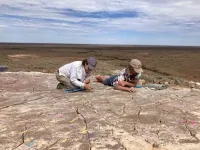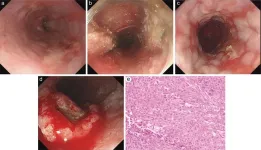(Press-News.org) Everyone has a past. That includes the millions of species of insects, arachnids, and nematode worms that make up a major animal group called the Ecdysozoa.
Until recently, details about this group’s most distant past have been elusive. But a UC Riverside-led team has now identified the oldest known ecdysozoan in the fossil record and the only one from the Precambrian period. Their discovery of Uncus dzaugisi, a worm-like creature rarely over a few centimeters in length, is described in a paper published today in Current Biology.
“Scientists have hypothesized for decades that this group must be older than the Cambrian, but until now its origins have remained enigmatic. This discovery reconciles a major gap between predictions based on molecular data and the lack of described ecdysozoans prior to the rich Cambrian fossils record and adds to our understanding of the evolution of animal life,” said Mary Droser, a distinguished professor of geology at UCR, who led the study.
The ecdysozoans are the largest and most species-rich animal group on Earth, encompassing more than half of all animals. Characterized by their cuticle — a tough external skeleton that is periodically shed — the group comprises three subgroups: nematodes, which are microscopic worms; arthropods, which include insects, spiders, and crustaceans; and scalidophora, an eclectic group of small, scaly marine creatures.
“Like many modern-day animal groups, ecdysozoans were prevalent in the Cambrian fossil record and we can see evidence of all three subgroups right at the beginning of this period, about 540 million years ago,” said Ian Hughes, a graduate student in marine biology at Harvard University and the paper’s first author. “We know they didn’t just appear out of nowhere, and so the ancestors of all ecdysozoans must have been present during the preceding Ediacaran period.”
DNA-based analyses, used to predict the age of animal groups by comparing them with their closest living relatives, have corroborated this hypothesis. Yet ecdysozoan fossil animals have remained hidden among scores of animal fossils paleontologists have discovered from the Ediacaran Period.
Ediacaran animals, which lived 635-538 million years ago, were ocean dwellers; their remains preserved as cast-like impressions on the seabed that later hardened to rock. Hughes said uncovering them is a labor-intensive, delicate process that involves peeling back rock layers, flipping them over, dusting them off, and piecing them back together to get “a really nice snapshot of the sea floor.”
This excavation process has only been done at Nilpena Ediacara National Park in South Australia, a site Droser and her team have been working at for 25 years that is known for its beautifully preserved Ediacaran fossils.
“Nilpena is perhaps the best fossil site for understanding early animal evolution in the world because the fossils occur during a period of heightened diversity and we are able to excavate extensive layers of rock that preserve these snapshots,” said Scott Evans, an assistant professor of Earth-Life interactions at Florida State University and co-author of the study. “The layer where we found Uncus is particularly exciting because the sediment grains are so small that we really see all the details of the fossils preserved there.”
While the team didn’t set out to find an early ecdysozoan during their 2018 excavation, they were drawn to a mysterious worm-like impression that they dubbed “fishhook.”
“Sometimes we make dramatic discoveries and sometimes we excavate an entire bed and say ‘hmmm, I’ve been looking at that thing, what do you think?’” Hughes said. “That’s what happened here. We had all sort of noticed this fishhook squiggle on the rock. It was pretty prominent because it was really, really deep.”
After seeing more of the worm-like squiggles the team paid closer attention, taking note of fishhook’s characteristics.
“Because it was deep, we knew it wasn’t smooshed easily so it must have had a pretty rigid body,” Hughes said. Other defining characteristics include its distinct curvature and the fact that it could move around — seen by trace fossils in the surrounding area. Paul De Ley, an associate professor of nematology at UCR, confirmed its fit as an early nematode and ruled out other worm types.
“At this point we knew this was a new fossil animal and it belong to the Ecdysozoa,” Hughes said.
The team called the new animal Uncus, which means “hook” in Latin, noting in the paper its similarities to modern-day nematodes. Hughes said the team was excited to find evidence of what scientists had long predicted; that ecdysozoans existed in the Ediacaran Period.
“It’s also really important for our understanding of what these early animal groups would have looked like and their lifestyle, especially as the ecdysozoans would really come to dominate the marine ecosystem in the Cambrian,” he said.
The paper is titled “An Ediacaran bilateran with an ecdysozoan affinity from South Australia.” Funding for the research came from NASA.
END
Tiny worm makes for big evolutionary discovery
UC Riverside scientists have described ‘Uncus,’ the oldest ecdysozoan and the first from the Precambrian period
2024-11-18
ELSE PRESS RELEASES FROM THIS DATE:
Cause of the yo-yo effect deciphered
2024-11-18
Anyone who has ever tried to get rid of a few extra kilos knows the frustration: the weight drops initially, only to be back within a matter of weeks – the yo-yo effect has struck. Researchers at ETH Zurich have now been able to show that this is all down to epigenetics.
Epigenetics is the part of genetics that’s based not on the sequence of genetic building blocks but on small yet characteristic chemical markers on these building blocks. The sequence of building blocks has evolved over a long period of time; we all inherit them from our parents. Epigenetic markers, on the other hand, are more dynamic: environmental factors, our eating habits and the condition of our body ...
Suicide rates for young male cancer survivors triple in recent years
2024-11-18
LOS ANGELES — New research published in JAMA Network Open from USC Norris Comprehensive Cancer Center, part of Keck Medicine of USC, suggests that among all cancer survivors, male adolescents and young adults (AYA) have the highest rate of death by suicide.
The study also reports that the number of suicide deaths in the AYA male cancer survivor group (ages 15-39) increased three-fold during the 21-year-study period. In 2021, one in 65 deaths among the group was attributed to suicide. Suicide deaths have also increased for other cancer ...
Achalasia and esophageal cancer: A case report and literature review
2024-11-18
Achalasia is primarily caused by the degeneration of the myenteric plexus in the esophageal wall, leading to impaired relaxation of the lower esophageal sphincter (LES) and loss of esophageal peristalsis. Although the exact etiology is not fully understood, it is believed to involve autoimmune mechanisms and viral infections. Key pathological features include the absence of peristalsis, LES hypertonicity, and symptoms such as dysphagia and regurgitation. In this condition, the esophagus fails to contract and move food toward the stomach, while the LES ...
Authoritative review makes connections between electron density topology, future of materials modeling and how we understand mechanisms of phenomena in familiar devices at the atomistic level
2024-11-18
2024 marks an important milestone with the publication of a comprehensive review in Chemical Reviews on electron density-based methods. The review, authored by an international team, was spearheaded by leading researchers from Institute of Science Tokyo (Sergei Manzhos and Manabu Ihara of the Ihara-Manzhos lab) and included collaborators from Canada (Paul Ayers of McMaster University and Cherif Matta of Mount Saint Vincent University), China (Samantha Jenkins of Hunan Normal University), and the USA (Michele Pavanello from Rutgers University). The project also saw significant contributions from young researchers, Daniel Koch from ...
Understanding neonatal infectious diseases in low- and middle-income countries: New insights from a 30-year study
2024-11-18
Researchers from Peking University have conducted an in-depth study on the epidemic status, secular trends, and risk factors of 15 common neonatal infectious diseases across low- and middle-income countries (LMICs) from 1990 to 2019. The study, published in Health Data Science, provides a comprehensive overview of the changes in incidence and mortality rates, identifying key trends and potential areas for targeted public health interventions to improve neonatal health outcomes.
Neonatal infectious diseases remain a significant cause of morbidity and mortality in LMICs, where newborns are particularly vulnerable to infections due to underdeveloped immune systems ...
This year’s dazzling aurora produced a spectacular display… of citizen science
2024-11-18
Citizen scientists in Japan enabled researchers to learn why May 2024’s aurora appeared a magenta color over the country. This effort in extending research beyond academies and laboratories has greater consequence for humanity than explaining pretty lights
Around the world, the historic geomagnetic superstorm of late spring 2024 inspired millions of non-scientists around the world—many armed with highly sensitive smartphone cameras—to take a fantastic, unprecedented number of images of the aurora it produced.
In ...
New oral drug to calm abdominal pain
2024-11-18
University of Queensland researchers have developed a new class of oral painkillers to suppress chronic abdominal pain that is based on the peptide hormone oxytocin that drives childbirth contractions.
Associate Professor Markus Muttenthaler from UQ’s Institute for Molecular Bioscience led a team that has changed the chemical structure of oxytocin to make it gut-stable after earlier work revealed the hormone could treat abdominal pain.
Dr Muttenthaler said there was an urgent need for new ...
New framework champions equity in AI for health care
2024-11-18
(Toronto, November 18, 2024) A recent study published in the Journal of Medical Internet Research introduced the EDAI framework, a comprehensive guideline designed to embed equity, diversity, and inclusion (EDI) principles throughout the artificial intelligence (AI) lifecycle. Led by Dr Samira Abbasgholizadeh-Rahimi, PhD, the Canada Research Chair (Tier II) in AI and Advanced Digital Primary Health Care, the research addresses a significant gap in current AI development and implementation practices in health and oral health care, which often overlook critical EDI factors. With EDAI, AI ...
We finally know where black holes get their magnetic fields: Their parents
2024-11-18
Black holes are one of the most enigmatic stellar objects. While best known for swallowing up their surroundings into a gravity pit from which nothing can escape, they can also shoot off powerful jets of charged particles, leading to explosive bursts of gamma rays that can release more energy in mere seconds than our sun will emit in its entire lifetime. For such a spectacular event to occur, a black hole needs to carry a powerful magnetic field. Where this magnetism comes from, however, has been a long-standing ...
Multiple sclerosis drug may help with poor working memory
2024-11-18
Fampridine is currently used to improve walking ability in multiple sclerosis. A new study shows that it could also help individuals with reduced working memory, as seen in mental health conditions like schizophrenia or depression.
Remembering a code for long enough to type it in; holding a conversation and reacting appropriately to what is being said: in everyday situations like these, we use our working memory. It allows a memory to be actively retained for a few seconds. Certain conditions, such as schizophrenia ...
LAST 30 PRESS RELEASES:
New expert guidance urges caution before surgery for patients with treatment-resistant constipation
Solar hydrogen can now be produced efficiently without the scarce metal platinum
Sleeping in on weekends may help boost teens’ mental health
Study: Teens use cellphones for an hour a day at school
After more than two years of war, Palestinian children are hungry, denied education and “like the living dead”
The untold story of life with Prader-Willi syndrome - according to the siblings who live it
How the parasite that ‘gave up sex’ found more hosts – and why its victory won’t last
When is it time to jump? The boiling frog problem of AI use in physics education
Twitter data reveals partisan divide in understanding why pollen season's getting worse
AI is quick but risky for updating old software
Revolutionizing biosecurity: new multi-omics framework to transform invasive species management
From ancient herb to modern medicine: new review unveils the multi-targeted healing potential of Borago officinalis
Building a global scientific community: Biological Diversity Journal announces dual recruitment of Editorial Board and Youth Editorial Board members
Microbes that break down antibiotics help protect ecosystems under drug pollution
Smart biochar that remembers pollutants offers a new way to clean water and recycle biomass
Rice genes matter more than domestication in shaping plant microbiomes
Ticking time bomb: Some farmers report as many as 70 tick encounters over a 6-month period
Turning garden and crop waste into plastics
Scientists discover ‘platypus galaxies’ in the early universe
Seeing thyroid cancer in a new light: when AI meets label-free imaging in the operating room
Neutrophil-to-lymphocyte ratio may aid risk stratification in depressive disorder
2026 Seismological Society of America Annual Meeting
AI-powered ECG analysis offers promising path for early detection of chronic obstructive pulmonary disease, says Mount Sinai researchers
GIMM uncovers flaws in lab-grown heart cells and paves the way for improved treatments
Cracking the evolutionary code of sleep
Medications could help the aging brain cope with surgery, memory impairment
Back pain linked to worse sleep years later in men over 65, according to study
CDC urges ‘shared decision-making’ on some childhood vaccines; many unclear about what that means
New research finds that an ‘equal treatment’ approach to economic opportunity advertising can backfire
Researchers create shape-shifting, self-navigating microparticles
[Press-News.org] Tiny worm makes for big evolutionary discoveryUC Riverside scientists have described ‘Uncus,’ the oldest ecdysozoan and the first from the Precambrian period






